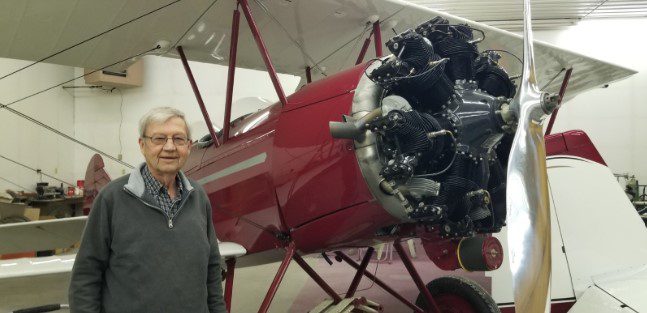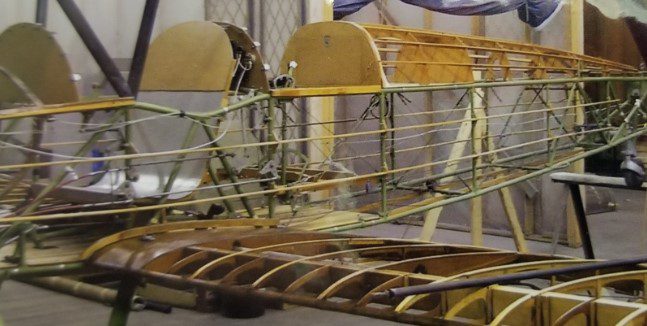

VELVA -- Inside a hanger a few miles north of here sits a glistening airplane, dark red with brilliant white wings. Two of them. The stunning biplane was reconstructed by Larry Linrud, 74, a man who has been around airplanes most of his life.
Linrud spent nearly 40 years in the aerial spraying business. In the 1970s and 80s, he also managed the Wahpeton airport. It was there that he began rebuilding airplanes. Retired now, his passion for aviation continues as well as his desire to stay active.
"I'm always looking for something to do, always tinkering around."Larry Linrud
“I can’t sit. I’m always looking for something to do, always tinkering around,” said Linrud.
The biplane is a throwback to the early days of aviation, those years of infancy before single wing aircraft became the norm. Linrud’s rebuilt gem is a 1928 Travel Air which was a top-selling airplane from 1925-28.
“This plane was probably a little ahead of its time back then,” said Linrud. “Travel Air was the first one to come with a steel tube fuselage structure. There’s not a lot of them left.”
Linrud acquired the biplane from a family in Colorado. It was the project of their father who passed away before the work could be finished.
"It was in parts and pieces."Linrud
“It took two trailers to get it up here,” recalled Linrud. “It was parts and pieces. The spars in the wing were broken, and I had to replace a bunch of ribs. I pretty much worked on it every day since January of 2020.”
The return of the early aircraft to North Dakota was a homecoming of sorts. The plane was originally owned by a man in Dazey back in the 1930s. According to Linrud, the man was a crop sprayer who also bought and sold airplanes. Dazey is a small town in northwestern Barnes County.
Inside Linrud’s combination shop, paint booth, and hanger, the rebuilding project proved to be quite challenging. Linrud was up for the task.
“The airplane actually came with a HISSO engine. Since you can’t find them anymore and they weren’t that reliable in the first place, a lot of guys who rebuild these are putting this 220 Continental radial engine on them,” said Linrud while nodding toward the gleaming black engine at the front of the aircraft.
Linrud had to make a few other changes too, even making a few parts that are impossible to find since they quit manufacturing them many years ago. The Velva man also made some modifications during the restoration project.
"It's all these little things that you have to get done before the airplane is actually legal."Linrud
“The airplane actually came with a tail skid rather than a wheel,” explained Linrud. “Since the real wheel didn’t come on the airplane, I need to have that approved by the government. It’s all these little things that you have to get done before the airplane is actually legal.”
Linrud is waiting for paperwork to be processed and for the arrival of an inspector who will put eyes on the aircraft before it can be approved for flight. He has cranked up the engine and listened to it rumble, a sound from yesteryear.
According to Linrud, early-day airplanes were constructed using existing parts from automobile and farm implement manufacturers. The original 30-inch wheels, narrow, were smooth. A similar wheel is still made today, but with a tread. The wood propeller was replaced by a 99-inch metal prop. Linrud added brakes to his Travel Air, something that was an option on the later models.
The cockpit is vastly different from what is found in aircraft today. It is wide open and there are no navigation instruments.

“It’s a whole lot different,” said Linrud with a broad smile. “There’s a few gauges, but they are mostly engine gauges. You have air speed, altimeter, and a compass. That’s about it.”
The biplane is a two-seater, flown from the rear seat with the passenger seat located in front of the pilot. The fuel gauge sits above the engine, several feet from the pilot who would have to look over a passenger’s shoulder to read it.
One of the most time-consuming elements of the rebuilding process was the covering of the chassis and wings. Original biplane wings were covered with a combination of linen and cotton. Water was used to shrink the fabric to make it fit tight to the wings. Linrud used Dacron cloth and a regular clothes iron.
“Covering an airplane is a lot of work. It’s labor intensive,” said Linrud.
The extensive work included several coats of material to fill the weave of the fabric, use of reinforcing tape, gluing the fabric onto the wing, and adding six coats of sealant to prevent ultraviolet rays from degrading the fabric.
“This fabric will last 40 years,” claimed Linrud while running his hand across the top of the biplane’s lower wing. “When aviation started out, they thought you had to have two wings in order to develop enough lift to fly.”
Today’s aircraft designs pay particular attention to the balance point, a center of gravity for the aircraft. That concept was never even a consideration in the early days of aircraft building.
"When they built these, nobody knew anything about the center of gravity."Linrud
“When they built these, nobody knew anything about the center of gravity. They just went out and flew it. If it flew pretty good, that was fine and they didn’t worry about it,” said Linrud. “Even the elevator on the tail wing, how many degrees up and down, there wasn’t any standards back then. They didn’t worry about it. They just rigged it.”
Sitting alongside Linrud’s 1928 biplane is a single wing aircraft, an RV-14 Vans that he built from a kit. A few yards away is a two-person helicopter, also built by Linrud. He flies both regularly.
When completed, this biplane will be a certain attention-getter. What’s his plan for it once he gets it in the air?
“I really don’t need an open cockpit biplane,” laughed Linrud. “It’s too cold to fly the dumb thing. I’ll probably fly it next summer and then put it up for sale.”
It will be quite a sight, no arguing that. Today biplanes are popular attractions at air shows throughout the country, relics of the earliest days of aviation. Sometime next summer, expect Linrud and his 1928 Travel Air biplane to take center stage in the skies around Velva.
